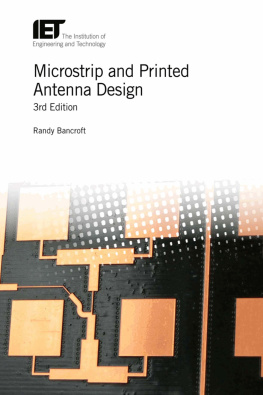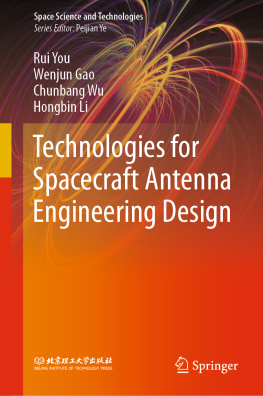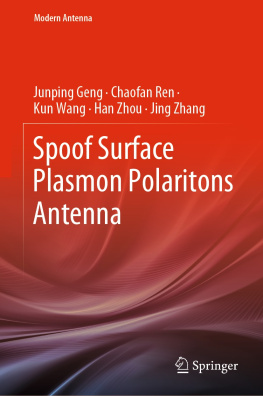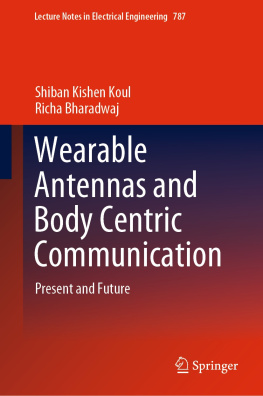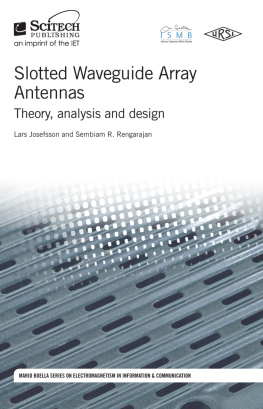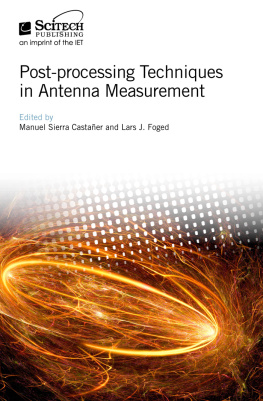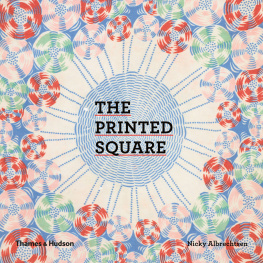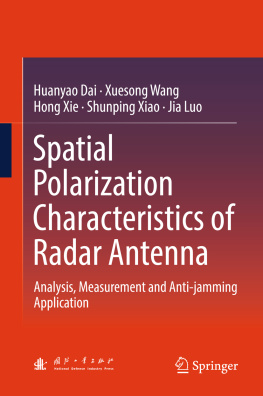Randy Bancroft - Microstrip and Printed Antenna Design
Here you can read online Randy Bancroft - Microstrip and Printed Antenna Design full text of the book (entire story) in english for free. Download pdf and epub, get meaning, cover and reviews about this ebook. year: 2020, publisher: Institution of Engineering & Technology, genre: Children. Description of the work, (preface) as well as reviews are available. Best literature library LitArk.com created for fans of good reading and offers a wide selection of genres:
Romance novel
Science fiction
Adventure
Detective
Science
History
Home and family
Prose
Art
Politics
Computer
Non-fiction
Religion
Business
Children
Humor
Choose a favorite category and find really read worthwhile books. Enjoy immersion in the world of imagination, feel the emotions of the characters or learn something new for yourself, make an fascinating discovery.
- Book:Microstrip and Printed Antenna Design
- Author:
- Publisher:Institution of Engineering & Technology
- Genre:
- Year:2020
- Rating:4 / 5
- Favourites:Add to favourites
- Your mark:
- 80
- 1
- 2
- 3
- 4
- 5
Microstrip and Printed Antenna Design: summary, description and annotation
We offer to read an annotation, description, summary or preface (depends on what the author of the book "Microstrip and Printed Antenna Design" wrote himself). If you haven't found the necessary information about the book — write in the comments, we will try to find it.
Microstrip and Printed Antenna Design — read online for free the complete book (whole text) full work
Below is the text of the book, divided by pages. System saving the place of the last page read, allows you to conveniently read the book "Microstrip and Printed Antenna Design" online for free, without having to search again every time where you left off. Put a bookmark, and you can go to the page where you finished reading at any time.
Font size:
Interval:
Bookmark:
Microstrip antenna substrates
The selection of a substrate material is a balance between the required electrical, mechanical, and environmental performance required by a design versus economic constraints. Generally, if one has the available design volume to use air as a substrate for a microstrip antenna, this is a good choice. The antenna efficiency is high and the gain is maximized as is the impedance bandwidth of a conventional microstrip antenna. The surface wave loss when air is used as a substrate is minimal.
When a dielectric substrate is selected, one is often interested in a material with the lowest loss tangent  available. The loss tangent is a metric of the quantity of electrical energy which is converted to heat by a dielectric. The lowest possible loss tangent maximizes the antenna efficiency (decreases the losses) and is expanded upon in Section 2.6 of Chapter 2.
available. The loss tangent is a metric of the quantity of electrical energy which is converted to heat by a dielectric. The lowest possible loss tangent maximizes the antenna efficiency (decreases the losses) and is expanded upon in Section 2.6 of Chapter 2.
The relative dielectric permittivity,  , of the substrate determines the physical size of a patch antenna. The larger the dielectric permittivity, the smaller the element size, but also the smaller the impedance bandwidth and directivity. The surface wave loss also increases. The use of substrates with higher dielectric permittivity also tightens fabrication tolerances [].
, of the substrate determines the physical size of a patch antenna. The larger the dielectric permittivity, the smaller the element size, but also the smaller the impedance bandwidth and directivity. The surface wave loss also increases. The use of substrates with higher dielectric permittivity also tightens fabrication tolerances [].
The tolerance of the dielectric permittivity value is also of significant importance in manufacturing yield. A Monte Carlo-type analysis using the cavity model is a good method of estimating antenna manufacturing yield for a rectangular microstrip antenna when etching tolerance, substrate thickness tolerance, feed point location tolerance, and dielectric tolerances are known. Substrate electrical and physical parameters also vary with temperature. Work by Kabacik and Bialkowski indicates that Teflon/fiberglass substrates can have a significant variation of dielectric permittivity for many airborne and space-borne applications []. The dielectric permittivity and loss tangent of Teflon/fiberglass often differed from what was quoted by manufacturers in their data sheets when compared with measurements and were valid over a much narrower temperature range than encountered in many aerospace applications. The performance variations are due to changes in the material dielectric propertiesthermal expansion had a minor effect on microstrip antenna performance.
Commercially available substrates and laminates have different requirements for processing. Details of fabrication issues and methods may be found in the literature and directly from manufacturers [].
Generally, relative dielectric permittivity  and loss tangent
and loss tangent  increase with temperature. In space applications, moisture outgassing produces a lower dielectric permittivity and loss tangent.
increase with temperature. In space applications, moisture outgassing produces a lower dielectric permittivity and loss tangent.
Generally, the metal cladding attached to a dielectric substrate material is copper. Two types of copper foil are used as cladding, rolled foil and electrodeposited foil. Rolled foil is passed through a rolling mill a number of times until the desired physical dimensions are obtained and is then bonded to the substrate. Rolled copper has a polished mirror-like appearance. It is generally used for flexible circuitry. Electrodeposited foil is created by electrodeposition of copper onto an inert form, which is generally a rolling titanium or steel drum. A thin layer of copper is continuously removed from the form and then bonded to a substrate [].
Oxidation of copper traces is the primary cause of copper bond failure over time. The copper traces oxidize on both sides (top and bottom) of the trace. The diffusion of oxygen in the substrate material causes the bottom side of the trace to oxidize. Continuous ambient temperatures above 250 F will ultimately degrade the copper bonds on the surface of the board. The most effective way to mitigate this oxidation is to use an effective high temperature conformal coating. This coating will provide a barrier between the air and the surface of the resin and copper traces [].
The computation of characteristic impedance and losses of a microstrip transmission line (see Appendix C) depend on the copper foil thickness. The copper cladding is not generally presented as a thickness, but is indirectly derived from a provided mass over a given area. In Table ]. Thinner copper traces have smaller etching undercut than thicker traces. This allows for fine (narrow) traces as compared to thicker copper. Thicker copper has higher power handling capability. This is important where the small cross-section of a trace could produce heat build-up and eventual failure.
Table A.1 Metric copper foil mass and foil thickness
| Foil mass/area | Foil thickness | Tolerance |
|---|---|---|
| 150 g/m2 | 18 m | 4.9 m |
| 300 g/m2 | 34 m | 4.9 m |
| 600 g/m2 | 70 m | 7.5 m |
| 1200 g/m2 | 104 m | 10.0 m |
Table A.2 US copper foil weight and foil thickness
| Foil weight/area | Foil thickness | Tolerance |
|---|---|---|
| 1/2 oz/ft2 | 0.0007 in | 0.0002 in |
| 1 oz/ft2 | 0.0014 in | 0.0002 in |
| 2 oz/ft2 | 0.0028 in | 0.0003 in |
| 4 oz/ft2 | 0.0056 in | 0.0004 in |
The surface roughness of copper can produce considerable loss at higher frequencies. The effect becomes significant when the skin depth of copper becomes less than or equal to the surface roughness of the copper cladding. Often a rough surface is used to improve the adhesion of the copper cladding to a dielectric substrate. The surface roughness of commonly available copper cladding is given in Table ].
Table A.3 Copper foil surface roughness
| Type of cladding | Copper surface roughness (RMS) |
|---|---|
| High-profile ED copper | 2400 nm |
| Standard ED copper | 1200 nm |
| Low-profile ED copper | 600 nm |
| Rolled annealed copper | 300 nm |
The skin depth of copper for selected frequencies is given in Table ].
Table A.4 Skin depth for copper with frequency
| Frequency (GHz) | Skin depth (nanometers) |
|---|---|
| 1 | 2063 nm |
| 10 | 652 nm |
| 50 | 292 nm |
| 77 | 235 nm |
| 110 | 197 nm |
Dielectric substrates used to construct microstrip antennas (and radomes) may be grouped into plastics like fluoropolymers, such as Teflon [polytetrafluoroethylene (PTFE)] and cross-linked polystyrene (Rexolite 1422), ceramics, such as Al2O3 ( alumina) or silicon nitride Si3N4, and glasses, such as E-Glass, which are used in most Teflonfiberglass microwave substrates.
In some commercial applications, a planar antenna may be enclosed within an injection molded radome. The dielectric properties of the resins used are a very important consideration in an injection molded radome design. The resin should have known moisture absorption characteristics. Low moisture absorption is important in maintaining a stable resonance frequency and loss characteristics in environments which have humidity changes.
Font size:
Interval:
Bookmark:
Similar books «Microstrip and Printed Antenna Design»
Look at similar books to Microstrip and Printed Antenna Design. We have selected literature similar in name and meaning in the hope of providing readers with more options to find new, interesting, not yet read works.
Discussion, reviews of the book Microstrip and Printed Antenna Design and just readers' own opinions. Leave your comments, write what you think about the work, its meaning or the main characters. Specify what exactly you liked and what you didn't like, and why you think so.

